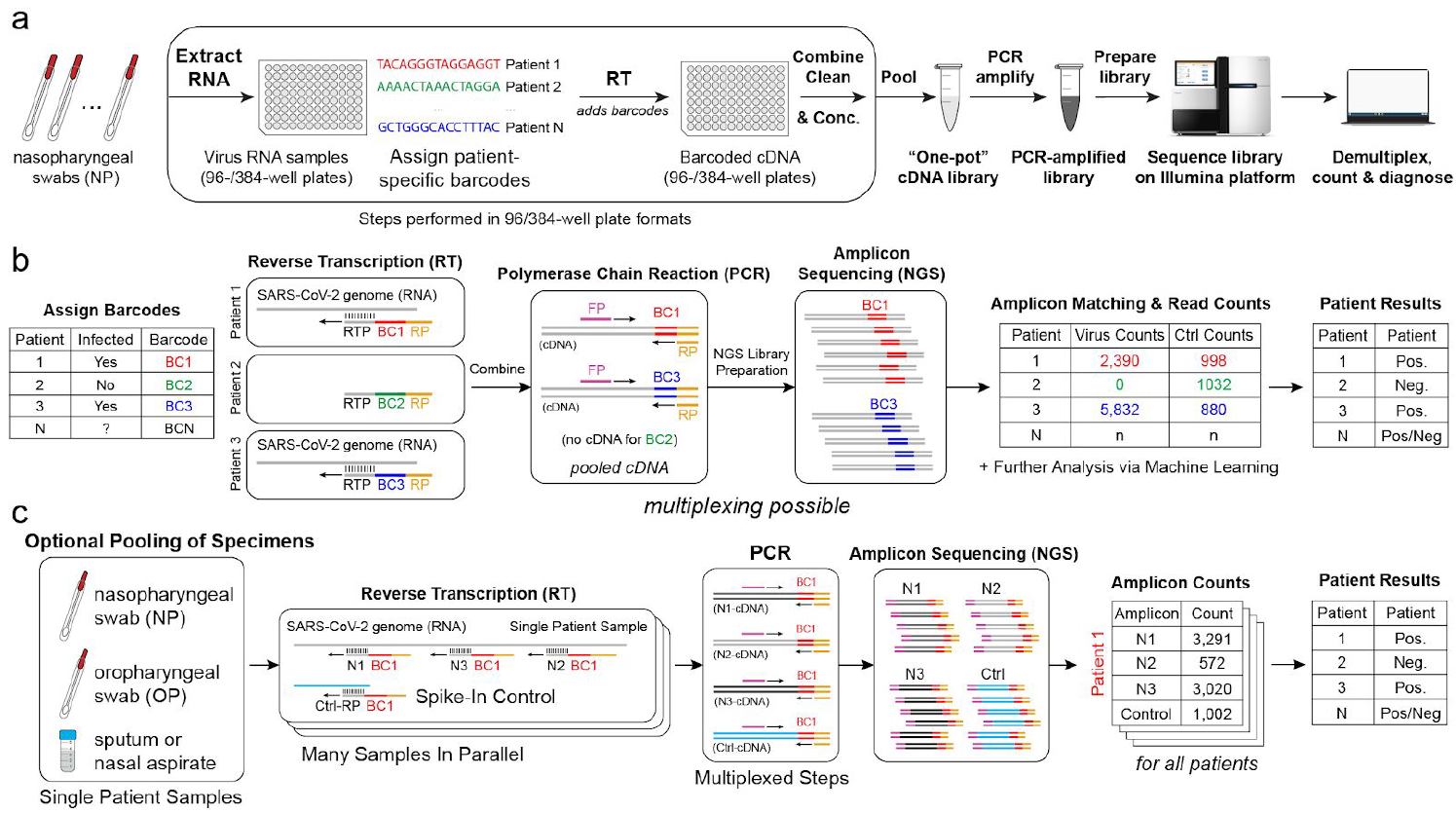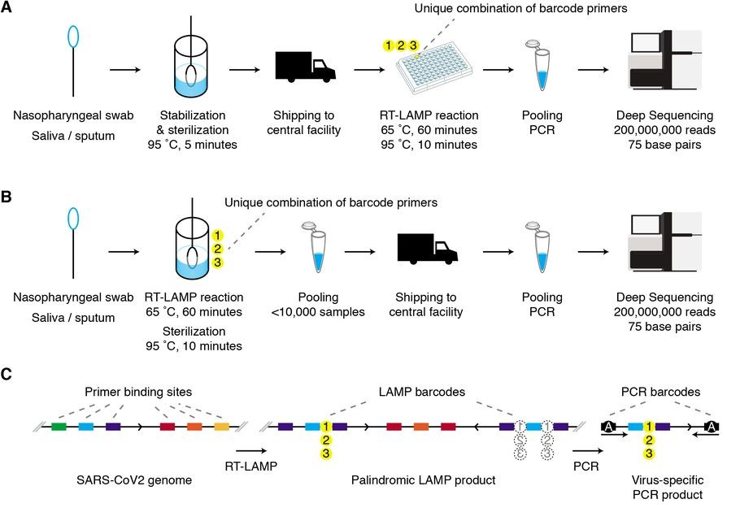2020-06-15 by Quick Biology Inc.
In June 2020, all 50 states in the USA have begun to reopen in some way. Some companies or institutes are providing employee coronavirus testing for returning to the office. Diagnostic capability is always challenging in such a SARS-CoV2 pandemic.
We summarized here of three strategies, which use next generation sequencing to do high throughput diagnostics. Method One developed by Pennsylvania State University (Fig.1), they designed 57600 RT (reverse transcription) primers with unique barcode sequences that link patients, synthesized cDNA with patient barcode information is pooled together and amplified in a single PCR of SARs-CoV2 genome. The amplicon library is sequenced, and final NGS reads are mapped, indicative of viral RNAs in patient-specific barcodes. Method two called HiDRA-seq by researchers in Switzerland, similar to method one but uses barcoded oligo-dT primers in RT steps (Fig.2), barcoded oligo-dT primers can capture not only viral genomic RNA but also subgenomic RNA transcripts generated in infected cells. Method three developed by Broad Institute in Boston, researchers not only get rid of RNA extractions steps but also combine isothermal nucleic acid amplification in their protocol, which makes more promising for sample handling, preparation. All three methods use barcoded RT primers for each patient on the goal of pooling samples into next generation sequencing, a powerful tool for high throughput.
Figure 1: A massively parallel diagnostic assay for COVID-19. (a) A schematic showing the overall workflow, including viral RNA extraction, reverse transcription using barcoded transcript-specific primers, PCR amplification of the pooled cDNA synthesis products, and next-generation sequencing to quantify the amounts of barcoded cDNA synthesis products. (b) Barcodes are first assigned to patient samples, followed by Reverse Transcription and cDNA synthesis using the corresponding barcoded RT primer. The RT primer contains a constant region where the reverse primer binds. The following PCR amplification uses the same forward and reverse primer for all barcoded cDNA variants. After next-generation sequencing of the amplicon library, read sequences are compared against the expected barcode and amplicon sequences, and the numbers of each barcode and amplicon are counted. (c) The proposed approach is naturally extended to simultaneously measuring cDNA levels from multiple amplicons and spike-in controls. Amplicon matching enables re-use of the same patient-specific barcode to produce different cDNA products, followed by mapping and counting. (Ref 1)

Figure 2: HiDRA-seq workflow. (A) Using a low volume liquid handling robot, the patients’ RNA is distributed in 384-well plates containing indexed oligo-dT primers. Barcoded cDNA is generated by reverse transcription and pooled into a single tube. Libraries are produced from SARS-CoV-2-specific amplicons and sequenced. Reads are de-multiplexed based on both a plate and a sample barcode and used for downstream diagnostic analysis. (Ref 2)

Figure 3: LAMP-seq workflow. Scalable deep-sequencing based approach for SARS-CoV-2 detection. (A)Schematic outline of a proposed scalable testing procedure. (B) Schematic of anticipated enzymatic reactions and reaction products. (C) Schematic illustration of a compressed barcode space allowing unique identification of millions of samples while minimizing barcode primer logistics. (ref 3)

Quick Biology is an expert in NGS applications. Find More at Quick Biology.
Ref:
1. Google Doc: https://docs.google.com/document/d/1kP2w_uTMSep2UxTCOnUhh1TMCjWvHEY0sUUpkJHPYV4
2. Yángüez, E. et al. HiDRA-seq : High-Throughput SARS-CoV-2 Detection by RNA Barcoding and Amplicon Sequencing Keywords. 1–16 (2020).
3. Schmid-Burgk, J. L. et al. LAMP-Seq: Population-Scale COVID-19 Diagnostics Using a Compressed Barcode Space. bioRxiv 2020.04.06.025635 (2020). doi:10.1101/2020.04.06.025635



